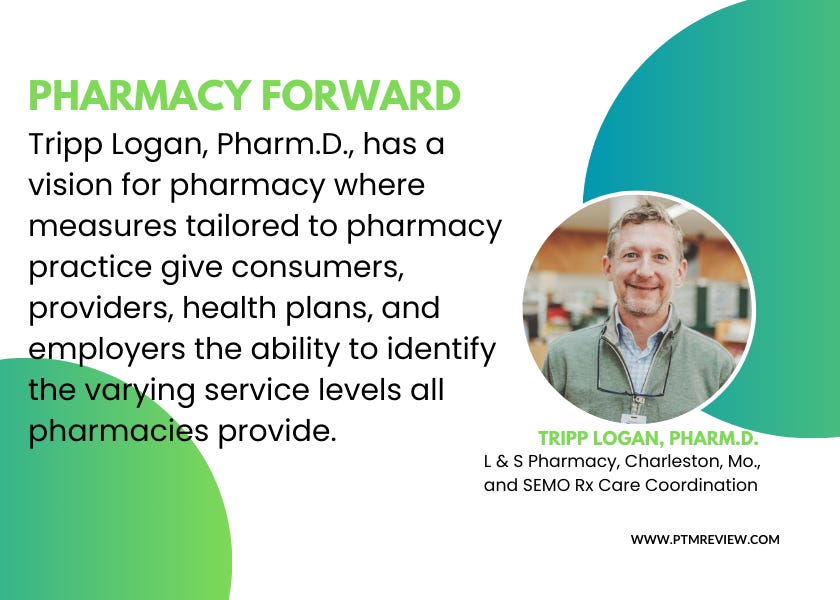The Imperative of Differentiation: Independent Pharmacy's Superpower?
Tripp Logan, Pharm.D., champions differentiating pharmacies based on the services they provide and their capacity for care coordination as essential for the future of community pharmacy success.
Pharmacy owners are innovators, and Tripp Logan, Pharm.D., is no exception. Well known in community pharmacy for his work at the National Community Pharmacists Association and CPESN, he now champions differentiating pharmacies based on the services they provide and their capacity for care coordination as essential for the future of community pharmacy success.
Logan has seen the pharmacy landscape shift during his time in practice as co-owner of L & S Pharmacy in Charleston, Mo., along with his father, and SEMO Rx Care Coordination, an outcomes-based care coordination clinic. SEMO Rx Pharmacies and the SEMO Rx Care Coordination each maintain a strong focus on local care coordination, screenings, care gap closures, and helping local patients overcome their non-medical drivers of health.
“If you think of how much dialysis costs, say $100,000 a year, and if you push dialysis off 10 years at $100,000 a year, that’s a million dollars. If we did that for 30 people, you start doing the math on how much money our engagement between visits saves because we focused on closing these care gaps and helping people early.” - Tripp Logan, Pharm.D. on the power of community pharmacy
“To me, what’s exciting, and what I’ve witnessed since I graduated pharmacy school, is how pharmacies are different,” says Logan, who was awarded the NCPA Willard B. Simmons Independent Pharmacist of the Year award in 2024. “My dad was always very integrated with local providers,” says Logan. “He would go to the clinics and work there with them. I’ve watched it my whole life, but his pharmacy always looked like any other independent down the road on the provider list. To me, the future of community pharmacy practices is differentiating the pharmacies to providers. When they look down a list of pharmacies, in reality, pharmacies are not the same.”
This shift moves the focus from transactional dispensing to building longitudinal relationships and providing comprehensive patient care. His own practice, spanning three counties, and the dedicated care coordination clinic covering roughly seven counties, embodies this approach. These differentiated services include chronic care management, helping patients navigate the complexities of the healthcare system and insurance, providing essential education, and administering vaccinations.
“I would say that our pharmacy has 11 technicians who are cross-trained as community health workers. But then you go to the next pharmacy, and all they offer are prescriptions, which is fine for some patients,” Logan says. “Longitudinal care coordination and follow-up is fundamentally different than having a prescription mailed to you.”
Logan argues that this difference in service level is significant and should be recognized by consumers, providers, health plans, and employers. A major historical challenge to this differentiation has been the lack of standardized measures specific to pharmacy practice. Logan notes that while some health plan measures, like adherence rates, have been applied to pharmacies, they are often insufficient. These measures typically only cover a small number of patients within a pharmacy and don’t effectively show the overall performance of a specific pharmacy across its entire patient population or how it truly differs from another practice. Without clear, pharmacy-specific measures, it’s difficult for pharmacies to track their own quality improvement efforts.
Pharmacy Metrics that Matter
To address this gap, Logan co-founded a company called Seguridad (meaning “safety” in Spanish) three years ago. Pharmacy measures are necessary, says Logan, because a local employer may have to choose a pharmacy from a list of five pharmacies and they want to know which one to send their employees to. Or a health system may want to partner with transitions of care with pharmacies, but doesn’t know who’s the best at diabetes care. “It’s hard to tell which pharmacy is checking pediatric weight or which one has allergy status on file,” Logan says. “We’ve created some measure, called Seguridad Health Measures. We began an awareness campaign to reference existing measures that we think will help differentiate pharmacies. Pharmacy needs to measure so that we differentiate ourselves and track quality improvements.”
Keep reading with a 7-day free trial
Subscribe to Pharmacy Technology & Management Review to keep reading this post and get 7 days of free access to the full post archives.


